Documentation
and Notes - greatly augmented with commentary and
links - in support of my presentation of The
10 Step Process, Knowledge Management and Weak
Signal Research for the CHE PatchWorks DesignShop
at the VCBH Innovation Center on September 17, 2002 |
|
The 10 Step Model [link: 10 step model] was first developed in
July of 1987 for Capital Holding Corporation (now
Providian). It was a generalization of knowledge
management processes that we developed at MG Taylor
Corporation, between 1979 and 1982, to support DesignShops
and various project management activities.
|
This
process has been extensively tested in the Mentor
NavCenter (1981 - 1983) as an executive function
to keep a holding company and key divisions coordinated,
The Capital Holding Design Center (1987
- 1988), in support of several projects merging
many insurance companies; And, it has been employed
in several other client owned Taylor NavCenters
and by MG Taylor in over a 1,000 DesignShop events
between 1980 to 2002. |
Given
this extensive experience, we know the process works.
The full potential of the Model, however,
is yet to be realized. There are three reasons.
First, the success of the Model as a meeting
documentation, process support and project
management tool has obscured its greater potential
and use as a general knowledge management tool.
Second, the technical system (hardware and software)
required to track the high number of information
transactions on the scale and scope required to
sustain a broad application in a large scale distributed
organization is just becoming economical and ubiquitous.
Prior systems succumbed to scaling issues and platform
migration. And third, NavCenters, the natural environment
for the process, that support multiple activities
additional to group process events are only now
being built and fully employed. The Vanderbilt VCBH
Innovation Center is a beginning level example of this kind of
application. |
Therefore
the use of this Model/Process, up to now, has mostly
been episodic and wired together with ad-hoc systems
built from primitive off-the-shelf computing tools.
Nevertheless, the results in many cases have been extremely efficacious.
The amount of information captured, processed and
delivered - as a final product - 48 hours after
a DesignShop is but one demonstrates this capacity. The task which lies
ahead is to evolve the Model into a broad scoped System and
Method of work forming a practice throughout
an (often virtual) community-of-work which provides sustainability
and scale-ablity in an appropriate [link: appropriate response model] way. As with all Taylor designed products and services,
this can only be done in a client environment with
active client collaboration in both design and the implementation of the system. This requirement is
driven by the nature of knowledge-work
itself and the unique circumstances to be found in each organization.
|
The
10 Step Process, in practice, provides - on the recursion
level of corporations and global organizations -
the kind of mental integration common to
highly competent professionals doing work in their
own field of expertise. People are born with this
capacity built-in - as a potential. They
can train this natural gift and mold their metal
abilities to accomplish a high level of craft and
performance. An organization of people does not
have the wiring nor the protocols of this kind of
function built in - it has to make a SYSTEM that does this process. This system is composed of people,
work processes, disciplines, technology, and it
requires a “market” (network) to function
within. This system requires the integration of
many different types of agents and intelligence(s).
Many otherwise conflicting languages and protocols
have to be made one. The range of this
integration is across several agents that can be
treated as one kind: minds, teams, ValueWebs [link: valuewebs] - all of them viewed as network a [link: value web model components] architecture thereby creating agency. A reading list of books spanning
some of the key disciplines and seminal
concepts necessary to the crafting
such a system is provided
[link: taylor system and method basic reading list] for review. To function at the optimum level, all of these components are designed and embedded in the structure of an organization so as to function in a mind like way thus creating strong memory throughout that organization [link: strong Memory]
|
A
significant attribute of the 10 Step Process - in
any application - is that it be designed
to be as content neutral as possible crafted as a strong work disciple, to reliably
support emergent
[link: zone of emergence engine] results. It must be competent in traditional task management at the same time a powerful open-ended, evolving, transformational
work machine.
|
In
terms of information management, the bias
of the 10 Step Process is toward finding and creating
relationships, discovering unknown links, and in
creating the interface between system, computer,
human and groups of humans (and machine and systems)
more than in finding the most efficient way of storing
discrete, known information and retrieving it. What
is interesting, in this view, is what happens when
smart humans, smart computers and smart networks
interact thereby discovering new insights, creating
new information and making new knowledge and creative actions possible. |
The
10 Step Process is intended for complex distributed
organizations and the special knowledge management
issues they exhibit. While it works on the level
of an individual, small teams and projects, it is
designed to scale and work in environments of extreme
complexity involving high variety and rates-of-change. The
10 Step Process is an engine. A function.
It is the wiring and work protocol of Group Genius.
It supports the MIND of the organization.
It is engineering - not metaphor. |
While
all of this sounds quite esoteric and complex, the
beauty of The 10 Step Process is that the theory
is “reduced” to a simple system and practice each
step of which is governed by simple rules. The theory
and design of networks and living systems involves
complex issues; the practice of knowledge
management is actually simple. It does, however,
require a discipline uncommon in most modern
organizations. Today, mental and process disciplines
are mostly held in professional categories: science,
design, law, economics, accounting, engineering,
manufacturing, marketing and so on. Most organizations
tend to organize around these disciplines which
is silly because you buy cars from General Motors
not legal, design, engineering, manufacturing, marketing and so on. The so called management
processes are, in the main, the least disciplined
of all and the most subject to lose analogies and after-the-fact speculation and justifications. The integrated disciple of managing the
key asset of an organization - it’s KNOWLEDGE
- is rarely demanded from, nor practiced by anyone,
let alone senior management. Like any skill, it
has to be learned, practiced and technically supported
and, too often, this is not what senior people do.
And yet, of course, they are, in fact, the senior
knowledge workers of an organization. Take key individuals
out of the knowledge-creation and sharing loop and
the entire “system” breaks down. This is the consequence of poor systems design, sloppy practices and an astonishing absence of feedback and accountability. If any member of a recognized discipline practiced their art in the way which most management and knowledge integration is conducted, in most organizations, they would be fired for incompetence. Those now recognized as knowledge
workers are usually trapped in the specifics of
their field and do not practice cross discipline knowledge management
as a generality. The issue is too often relegated to IT as
an assumed database or data warehouse problem. Occasionally,
there is a hue and cry for knowledge management
and some organizations even make it a VP job. Knowledge
is treated like some kind of “thing”
that has to be caught, protected, made safe and
kept out of the rain. It has to be seen as a process and discipline which is ubiquitous and integrated throughout an organizational entity and it ValueWeb. It is a technical issue yet technology as we presently conceive of it will not accomplish the necessry result. |
Knowledge
is not a thing - it is a no-thing. It is created
by being used, it is kept by being used and it is
lost when not used. It is like money in
an economy. It is the currency of mind-full-ness. If it is not accessible to all members of a practice and across the organizational divisions of an entity, it quickly decays and distorts the mind-of-the-organization.
|
| Knowledge
cannot be managed in the old, limited, controlled sense
of the word. The conditions that allow knowledge
to emerge can be systematically established.
Knowledge disciplines can be defined and practiced.
The technical infrastructure can be built. It cannot be accomplished by the installation of an IT package.The 10
Step Process is a protocol (supported by
strict rules) that transforms these elements
into the reality of an intelligent organization. |
|
The
diagram (above) is one contemporary illustration
of the Model. It shows the steps of the process
in groups of activities. This is a useful way but not the only way to look at the
Model. Below, the 1997 version offers another perspective
- also useful for understanding certain aspects
of how the 10 Step Process functions and how it can be employed in
a project management circumstance.
|
The
essence of this process is that an information EVENT
(which could be formal or informal - planned or spontaneous)
is documented and that the documentation is entered
into a KnowledgeBase. The Knowledgebase
is searched for relevant information which
is linked and attached to the documentation. The
(thus augmented) documentation is then DISTRIBUTED
to a select portion of the ValueWeb
on a need-to-know basis in a format designed to
fit each recipient’s knowledge
profile. This action is TRACKED and
FEEDBACK (on both the utility of the knowledge
artifact as a communication and the content of it
in terms of usefulness to each recipient) is sought
and the capture of the feedback facilitated. The content of this feedback
is entered into the KnowledgeBase and all relevant
documents and links are updated. DESIGN
work for the next Event is then done and READ-AHEADS
distributed (both these documents and entered in
the KnowledgeBase with appropriate searches and
links conducted). The cycle repeats. Iterative work
is supported. Both individual “agents”
and the system, “agency,”get smarter.
|
| Over
time, more and more links are made between the various
“knowledge agents” in the Knowledgebase.
Strong channels are established. Information is chunked.
MEMORY
[link: memory in a complex system] is built. Human memory is augmented by system to become
GROUP memory. In advanced systems, a variety
of intelligent computer agents can be employed to
augment this process. This capability, however, is
not necessary for effective functioning. Computer
augmented or not, humans are central to the process.
It is the system-as-a-system that makes the capacity
and this includes humans as an active agent in the
process. |
| Multiple iterations reaching through multiple levels of recursion are necessary for true distributed memory of knowledge to emerge. Constant re-use is required for knowledge to remain viable. The agency of this knowledge must reach to at least one order of magnitude beyond the daily operations of an organizational entity in order to function as knowledge for that organization. Appropriate, to the kind of organization, feedback loops of a complex kind have to be embedded into the metabolism of the entity in order for the memory to remain healthy. The mind-of-the-organization requires the same care as does the mind of an individual. Knowledge management has little to do with the content per se - it is the systematic maintenance of the process. |
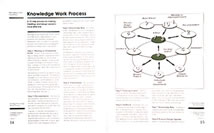 |
| The
1987 Model and description as expressed in a
early 90s MG Taylor Manual. |
|
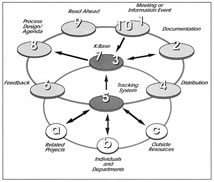 |
| This
version of the Model structures the process
into steps that can be bundeled into “triads”
of work each having rules and producer/user
tasks. |
|
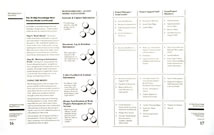 |
| This
matrix of tasks establishes the rules of engagement
of the system and individual roles
and accountability. |
|
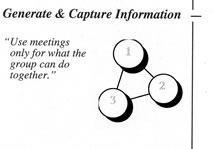 |
| Reduce
the number of meetings; Document them; design
the event structure and participation to work;
don’t use meetings for work that can
be done any other way. |
|
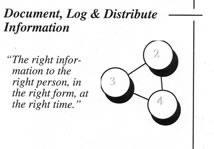 |
| If
a meeting cannot be documented, can you afford
to have it? Fewer meetings with better distribution
to the right people is a better economy. |
|
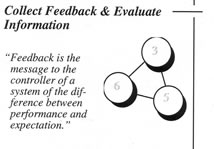 |
| A
message is not communication. Dialog and feedback
is necessary to keep a system stable and to
make shared memory. |
|
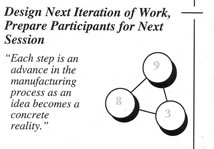 |
| When
purpose (intention), information, experience
and a framework (model) is fused in ACTION,
knowledge is created. |
|
data_information_knowledge |
Data,
Information, Knowledge |
There
is a significant difference between data, information
and knowledge. Each of these forms of mind-matter/content
are different and each follows their own rules.
|
DATA
is the raw atoms of experience. 9/11 meant one thing
before that date in 2001 - it means something else
now. It still means emergency. That something
else is made possible by context or, data/information
about the data in a way that frames it. INFORMATION
is data organized in some way that gives it meaning.
Having information, however, is not knowing.
You can have a great deal of information about something
and still not have KNOWLEDGE of it. This
is why (true) education
[link: 5 Es of education] has to combine
several modalities [link: coe designshop] of learning
[link: 5 points of mastery] and work in order to be effective. This is why a
knowledge-base has to focus on the interactions
of the users not only the static content. This is
why knowledge management is too often a means for
consultants to make money not a discipline transferred
to a client as a method that augments THE
critical process of their organization.
|
Several
factors have to be in place for knowledge
to exist: information about something, experience
and memory related to it; to have knowledge
you must have a purpose in mind and you have to
be in action. In this state, you are wired
into reality. There exists multiple feedbacks channels.
You are experienced-based but not only that - intellect
is in play (but not in control, by default) in a
circumstance of high frequency information flow.
This is the “sweet spot” in sports,
the one-with-the-universe in religion (which means
to “connect back”). It is the “divine
spark” in the creative process, the intuitive
leap in scientific discovery. You KNOW.
And, you know that you know. You do not, necessarily,
know what you know or if it is complete
for the task at hand. This is an issue that only
several iterations of work can resolve.
|
It
is in this this context and meaning that I think
of knowledge-formation
[link: design formation model] through iterations of work - each documented and
each producing a knowledge-artifact that is useful.
Each iteration improves on the last. Each, engages
the appropriate population of participants (be they
human or other kinds of agents).
|
Knowledge
MANAGEMENT, then, is the process of creating
the conditions for learning, the process
of design and the protocols and infrastructure of
document (artifact) control. It requires appropriate
application of engineering practices. It
is dependent on rigorous feedback of a complex kind
(feedback on feedback). To work, grow and evolve,
the system has to be operated.
|
This
approach to knowledge management is highly compatible
with rapid-prototyping techniques. In fact, it could
be argued that rapid Design/Build/Use
[link: design build use practice] cycles are inherently easier to bring into the 10
Step Process than more linier and slow development
methods. Documentation is easier when a full cycle
of work is completed and completed quickly. With
a focus on “shipping a product,” the
product itself (in each of its stages of development)
becomes a significant part of the documentation.
|
Tracking
Knowledge Formation |
To
do this well, you have to know where you are in
the total process of creation and use. The SolutionBox
Model provides this tracking capability. The
SolutionBox is composed of three Models: Creative
process, Design
Formation and Vantage
Points. These form a 7 x 7 x 7 grid that
charts the journey from idea to use. Thus,
the SolutionBox has 343 cells each representing
a “voice,” criteria for completeness
and test of veracity; Each is an “energy”
- a waypoint. Each is a means of feedback (and learning)
for the entire process. The establishment of 343
“states” is sufficiently fine grained
to provide a detailed mapping of a vast number of
human projects no matter their scale or complexity.
Yet, with the use of icons and a basic understanding
of each model, a mapping schema easy enough for
most people to learn and employ.
|
click on the SolutionBox to go to explaination |
The
SolutionBox has several uses: It is a means
of providing information about information. A document,
for example can be identified in terms of its “location”
(on the path) from concept to use. This helps the
user of the document to know how to “read”
it. It establishes a protocol in a community-of-practice
that builds a common basis for claims, completeness
and veracity. The SolutionBox can be a tag in the
search process. Artifacts of similar “maturity”
can be retrieved and compared. It provides “a
roadmap” of the creative process useful to
those facilitating the process and for those employing
it. They can know where they “are” and
have ready access to criteria, process rules and
tools as they relate to the state
[link: memory no. 12] they are in and about to move to.
|
The
creation, sharing and tracking of information and
knowledge across all areas of an organization’s
landscape is particularly critical given the dynamic
environment that exists today. In circumstances
of great change and complexity, and of large highly
connected organizations, collaborative work is not
just a good idea it is a must do. Problems
in modern organizations are complex and systemic.
They require the expertise available only from a
broad range of individual perspectives and disciplines
and cross discipline integration is a basic requirement.
Policy laden organizational structures cannot deal
with this. DESIGN is required. Peer
relationships are required. Ideas have to be formed,
tested, rejected or, when successful, taken to scale
quickly. The glue that holds this together is shared
knowledge and work protocols. It is this that makes
a “community of work - work.”
|
All
organizations, no matter if they think they do or
not, act to change the future. We are all futurists
only a few, however, try to get good at it. We all
act in the present based on a model of the past
and a expectation of the future. For many, this
is implicit. For some, explicit. For a very few,
the result of rigorous research. We call the latter
Weak
Signal Research [link: weak signal research]. Not all future research
is focused on weak signals but we emphasize this
aspect because it is the most critical. It takes
time to respond to new conditions. The intrinsic
response time to a given kind of challenge or opportunity
is the measure of the minimum anticipatory
modeling that must take place. In fact, a good rule
of thumb is that the look ahead time in any field
should be the length of 3 cycles of change. By definition,
Weak Signals are non-obvious, non-credible and obscure.
The key indicators have to be detected and separated
from the general background noise of a subject area
- the obvious ones are useful but not critical.
Weak Signal Research is a science-art in itself.
What interests us here is how the 10 Step process
can be employed to harvest the huge, latent potential
of forward thinking that usually remains untapped
in the vast majority of organizations.
|
Most
individuals in an organization have many interests
that range far wider than the work they do in the
organization. And, most individuals work in an organizational
circumstance that greatly focuses and narrows even
their professional scope. Add to this the fact that,
in most organizations, individuals are not systematically
connected in an organization wide network and you
can see that the flow of information throughout
the organization is greatly biased toward what it
already knows and directed to the immediate work
at hand. In addition, new ideas are easily discredited
because they will fail the test of veracity appropriate
for more mature ideas. This is due to not employing
a schema and disciple like the SolutionBox across
the organization. The result of all this is that
the flow of Weak Signals are too restricted and
do not find their way to one another where synergies
can occur. The organization suffers the equivalent
of what we would call repression or extreme predigest
in an individual. The Corporate mind is dead on
certain subjects. Individuals have separate puzzle
pieces but no game board to assemble them. This,
by the way, is but one example of organizations
- made up of well meaning and competent people -
can act is ways that if a single individual did
they would be highly criticized or in some cases
locked up for mental incompetence.
|
There
is, of course, a cure for this. Using the 10 Step,
SolutionBox, PatchWorks architecture and
Weak Signal processes, it is possible to wire together
this unused corporate capability. This cannot be
done like another intentional traditionally managed
project (which may have value in a mature domain
of inquiry). It has to be a heuristic process exercised
with rigor. Corporate wide channels and nets have
to be made that allow Weak Signals to flow through
the corporate mind, combine and come to “awareness”
when appropriate. A first step to building this
mind is understand where you are. A 7
Domains analysis can aid this exercise in corporate
self-awareness.
|
The
importance of systematic Weak Signal capability
being an embedded process of an organization
can be illustrated by the Jet Planes metaphor. Imagine
two state-of-the-art jets flying a full speed toward
one another on a collision course. By the time they
see one another, if flying visually, they are dead.
There simply is not enough reaction time. To survive,
they use radar. They “look out” to the
future. They navigate based on a technology augmented
model of that future not the verified present. They
correct by feedback: “the message from the
sensor(s) of a system to the controller of a system
of the difference between performance and expectation.”
|
| Weak
Signal Research is not the job of a few it is the
task of the many. It involves a process of systematic
scanning, imagination, design, testing and integration.
It requires many vantage points, levels of experience
and specific areas of knowledge, therefore, many people.
The potential remains latent, however, unless an integrating
system is in place and the “metabolism”
of that system is kept requisite with the change happening
both inside the organization and in it’s environment.
The organization has to function as an organism not
a simple mechanism. This is one way to overcome the requisite variety problem. |
Integrating
the 10 Step Process |
The
traditional organization is not structured in a
way that easily promotes systematic “10 stepping.”
Its entire architecture is actually based on the
separation of knowledge and control of its “integration.” For the 10 Step Process to work in an organization it has to be organized much more like a market - a network of agents. It has to be structured more like a brain and less like a simple machine. The good news is that this can be done without initially upsetting the hierarchy in place. A knowledge-network can be design and installed that cuts through traditional organization barriers. This network can serve the organization and become the basis for an organizational transformation that can evolve rather than be over designed and mandated.
|
| The 7 Domains Model puts an organizations “Body of Knowledge” in context of the other “domains” which have to be managed in order to create a systemically viable organization. The balance and connections between these domain is a critical as the domains themselves. People do not need to be managed as has been the practice for so long. The environment - the totally environment - in which they work can be made and managed, however, and this context is critical to sustained success. |
|
Humans
are not assets or resources of any organization.
Is not even appropriate to say that humans work
for an organization. It is more accurate to
say that humans employ organizational structures
and processes in order to lever their individual
abilities and capacities to accomplish some shared
goal. |
This
is not to argue, once an individual joins an organization,
that there are not duties and responsibilities due
the organization nor that a legitimate hierarchal
process does not exist. It does not sanction individuals
using an organization for narrow or personal goals
contrary to the benefit of other members or the
organization itself. Nor does it promote the use
of organization to perform social looting as we
have recently witnessed. Organizations are social
systems. They are, by definition, a shared space
made up of shared property. They have legitimate
legal rights (sometimes overstated) and responsibilities
(many times understated). As such, an organization’s
greatest asset is it’s Intellectual Capital. |
This
Intellectual Capital is composed of a number of
factors: intellectual property, organizational capability
to create and deliver products and services, and
access to a market to deliver those products and services. Organizational knowledge
is at the root of all these factors. Organizational
knowledge - we call it GroupGenius and
the Mind of the Organization - are the
least understood, least “managed” and
least attended to of all the so called properties
of the average organization. Organizational knowledge
is largely a matter of accident. It tends to exist
in the early stages of an organization’s development
and fade as success and growth drives out entrepreneurial
conditions and fosters growth beyond a small team. |
Just
as reworking organizational processes has been and
remains a rich source of costs savings, paying attention
to Organizational Knowledge is the great untapped
wealth-creating-potential that virtually every organization
has, but has not developed. This is true even though
there is much talk about the information economy
and the knowledge society. In practice,
it largely remains just that - talk. |
The
Models presented here provide a LANGUAGE to
give shape and voice to this potential. The 10 Step
Process provides the engine of creation
necessary to start the process of building the
mind of the organization. Implementing this
process is not easy nor is it to be had for free.
However, the costs are trivial compared to the potential
gain. |
| The
tool that we created at MG Taylor Corporation to facilitate
this process is the navCenter.™ The navCenter is a
means of creating and installing a new OS
into an organization that fits with their purpose
and culture and promotes their highest potential.
It is creating an new way of working in support
of those who are facilitating the transition of their
organization from an industrial model to a knowledge
paradigm and practice. This has been a part of our Mission
[link: mg taylor mission] from the beginning. |
click on graphic above to go to the Making, Ownership and Use
of navCenters |
|
|
| GoTo: Creative Augmentation |
|
|
| GoTo: Creative Habits/Embedded Processes |
|
|
| GoTo: Curriculum For the 21st Century |
|
|
| GoTo: Experience Based Education Model |
|
|
| GoTo: The 4 Step Recreation Process |
|
|
| GoTo: Information Factory |
|
|
| GoTo: IDIAP Dialog - 2005 |
|
|
| GoTo: Learning-Collaborative WorkSpace |
|
|
| GoTo: Media as Augmentation Tool |
|
|
| GoTo: 22 Aspects of Memory |
|
|
| GoTo: Practice - bringing idea into reality |
|
|
| GoTo: Solution Box Architecture |
|
|
| GoTo: ValueWeb Architecture |
|
|
| GoTo: Zone of Emergence Model |
|
|
Matt
Taylor
Nashville
September 20, 2002
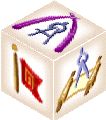
SolutionBox
voice of this document:
• ENGINEERING • STRATEGY •
• PRELIMINARY•
|
click on graphic for explanation of SolutionBox |
posted:
September 24, 2002
revised:
December 17, 2008
• 20020920.473711.mt
• 20020921.789718.mt
•
• 20020922.075531.mt
• 20020923.441411.mt •
• 20020924.450902.mt
• 20020925.344512.mt •
• 20070325.345100.mt • 20081217.500123.mt •
(note:
this document is about 85% finished)
Matt
Taylor 615 720 7390
me@matttaylor.com
Copyright©
Matt Taylor 1982, 1987, 2002, 2008 |
|
|